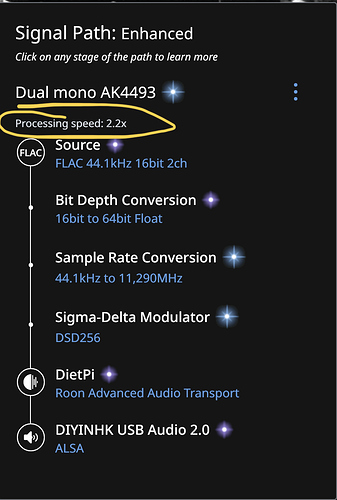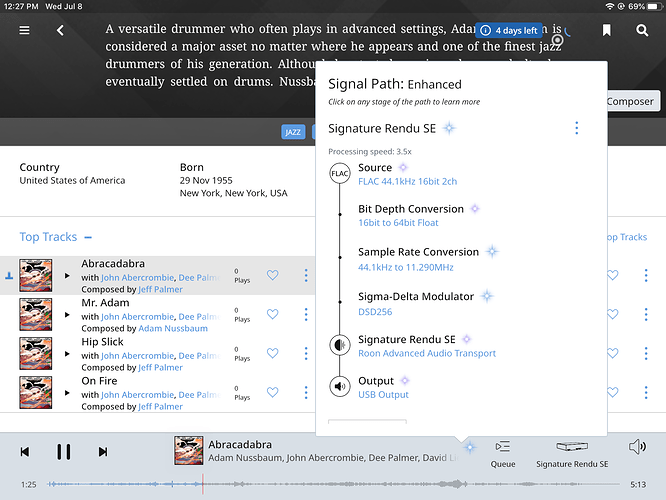Then what? You write to support anyway. Or you make a post asking why there can’t be add-ons to trouble shoot yellow warnings.
If you really need to see this stuff and make it actionable, run Linux.
If you don’t care and want simplicity, run ROCK.
Windows has WAY too much other stuff going on in the background. It is always best to install the Roon Operating system as it is tailored to only have what is needed for Roon and only Roon.
In that case (I see you linux connoisseur) to recommend a linux with a web interface in which you can monitor the state of the computer. It is with the web interface like ROCK, not with SSH server/client. And also to have this linux also easily installed and customized only under Roon as ROCK (I’m not a linux specialist).
Just in case I’ll clarify that I pay for Roon every year. 
If you are willing to put your everyday PC in the game, and have a light load on your NUC and monitor the temp, you could install Ubuntu server on the nuc, with only the roon bridge and lm-sensors installed. Run the core on your everyday pc. Monitor temp via ssh.
Should it still overheat, it will be surely a nuc problem. I can’t think of a lighter load on a nuc10.
Thank you @Jose_Vita. I am not smart enough to be a ‘linux connoisseur’ as @Katun generously suggested. 
But that is my point. A light operating system with a few tools should suffice. Plus, if something actually is wrong, you have an operating system that will let you figure out what the problem is.
Just trying to help. Or @danny could open a small exception on Rocks house rules, and enable some kind of developer mode on his rock, just to allow him to ssh and run lm-sensors. A brief period would suffice to assess whether the nuc is really faulty. I don’t know if it is possible, though.
I get what Roon is doing here. Part of the philosophy is explained in the Roon White Paper on Nucleus.
Solving the “enterprising hobbyist” problem
In our experience with high-end audio products, we’re frequently surprised by how their design makes tampering or end user modification of the operating system very easy. Some products boot from an SD card that is accessible to the user on the outside of the enclosure. These are easily tampered with by mounting the card and modifying its contents with a PC. Other products have published or easily-guessed root passwords, often allowing full access over a network.
Nucleus products have neither removable boot media nor a root password. The compartmentalized filesystem model means that on each boot, the Root Filesystem is recreated in a fresh state from a known working image, and on each update it is fully replaced. This “self-healing” quality means that any modifications made by an enterprising user would be destroyed either on the next reboot or the next update. This inconvenience is a significant deterrent to hobbyists interested in tweaking the system, and ensures that the state of a Roon OS can be trusted throughout the life of the product.
They want to keep it clean, simple, and tamper-proof. If that is the goal, where do you start making compromises and where does it end? If we can’t accept that compromise, there are other choices. Even if you give an alert, the user then needs to take an action. If it is temperature, then how do you fix it on a closed system? Do you want to know networking speed? Disk Fragmentation status, etc. etc.
We computer users can be an inquisitive bunch. It’s sort of refreshing this is kept closed. But I can see where the inquisitive users will want more info too.
I think you got their philosophy right. And I must say I agree 100% with that. After all, all we should need to enjoy music is press play. If you like to spend time tinkering, go play with minimserver settings…
Regardless, allowing some exceptions to meet a specific need like this case, for me, is walking that extra mile that sets good from great companies with regard to client attention. Agains, this is just the way I see the world.
Sent my NUC back and will be receiving another tomorrow. I hope the temps aren’t as scary. I will be installing Windows 10, my music playback applications, and some utilities, including a CPU monitor, so that it both remains dedicated to music and easily measured for CPU temperature.
I don’t mind using the NUC as server and controlling with the daily driver IF the NUC is where the upsampling occurs. I assume that is the case. I don’t want my general purpose computer bogged down with the heavy upsampling lifting.
Yes, upsampling occurs on the core. In this case, the NUC running RoonServer under Windows.
I’d steer clear of any and all third party utilities.
They have a obvious habit of mucking things up…
Thanks, Mikael, but I won’t operate a Windows computer without these.
The utilities consist of a remote access app that enables headless operation under Windows, a file manager that is more useful than Explorer, a temperature monitor, a partition manager that I probably could delete after initial setup, and the Samsung SSD diagnostics with which I benchmark.
Seriously, if Roon can’t has handle those, it’s not robust enough for me to rely on as my primary music server.
Not trying to pick your arguments apart here, but as an example, why would you want/need anything else than the built in RDP? Clients are available for all thinkable platforms and it works absolutely flawlessly from an iPad or whathaveya.
I work from home at times using only my iPad, remoting various Windows servers at work. (as well as my headless machines at home).
Windows Explorer? One of very few reasons why i use Win, to do file management tasks along with Robocopy.
As for the temp monitor i can see that there are few alternatives though. Just pick a reliable one that your MB/CPU manufacturer recommends.
Partition manager? Again, there is nothing more precise than DiskPart…
As you can tell, i have answers to all questions! 
Mikael, thanks, but, as you might imagine, I have reasons for each of these decisions.
Thanks for the suggestion that I return my NUC. Replacement arrived yesterday, I set it up under Windows (so I could monitor temps), I let it re-scan the library while playing, and then I let it continue playing overnight. Temps averaged around 65c and peaked in the 80’s, with one core at 89c. As long as I keep the averages below 70c and the peaks below 90c, it’s an improvement over the last one. I will repost if there are massive ticks upward for these numbers, but, for now, I am okay. I appreciate the input from everyone on this thread.
Please allow me to join those asking for a cpu temp monitor in ROCK. If there were one, I would be on that platform again now.
For whatever it’s worth, Audirvana with DSD256 upsampling is a potentially worse load than Roon doing the same thing. For the first time since I started oversampling, I pegged a core with Audirvana at 100c, which set off an alarm from CoreTemp. (Admittedly, I was doing a database scan at the same time, but Audirvana is always going to run that scan at startup, so that’s a real world case unless I don’t want to wait for a lengthy scan to finish before playing anything.)
roon does the same 
Great! You can try to limit CPU frequency in BIOS settings so that reduce processing speed, but not below 2.0x.

